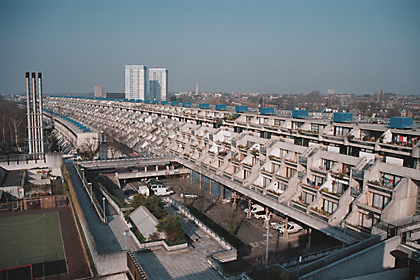This website uses cookies
This website uses cookies to enable it to function properly and to analyse how the website is used. Please click 'Close' to accept and continue using the website.



The Society is deeply saddened to learn of the death of Neave Brown, an architect known for some of the most innovative and successful low-rise high density social housing of the late 20th century.
His post-war public housing schemes demonstrated a commitment to building high quality homes which encouraged a sense of community. He was ambitious and challenged the status quo, drawing on historic precedent and using complex geometry to achieve cutting edge results. One of a number of talented young architects to be recruited by Sydney Cook’s pioneering architect’s department at the borough of Camden in the 1960s and 70s, it is not an exaggeration to say that Brown’s designs are now widely recognised to be amongst the best urban housing schemes in the world. Indeed, there are few architects whose work has been so important in the re-evaluation of social housing in this country – but until he received the RIBA Royal Gold Medal at the end of last year, his contribution to architecture had been greatly overlooked.
All of Brown’s UK buildings were eventually listed during his lifetime (a feat not yet accomplished by another architect). His best known is the mammoth Alexandra Road scheme (1978), an entire urban quarter covering nearly seven hectares which included 520 houses, a school, two care homes, light industry, shops, public house and community centre. With its stepped sections, curving traffic-free streets and underground parking, it is the most significant landscape of its type in the UK and widely regarded as one of the finest examples of public housing in Europe. But it was mired in controversy and became subject to a public inquiry. Although the findings showed that the architect was not responsible for the spiralling costs, Brown found it impossible to find work and the inquiry essentially ended his career in the UK.
It was a group of residents who in 1994 campaigned to get Alexandra Road listed at the high Grade of II* in response to poor maintenance works, which earned it the remarkable accolade as the first post-war housing estate to be listed, becoming the largest and youngest listed building in the process. This was an incredible achievement given its age and infamy, but it illustrates the way his housing is regarded by the people whose opinions matter the most – those that live there.
Born in 1929 in Utica, New York, Neave moved to the UK in the 1950s to study at the Architectural Association. After graduating he worked for three years at Lyons Israel Ellis and then for a short time for Middlesex county council, before setting up his own practice.
The first of his seminal works was a group of five houses in Winscombe Street, London, (1965). The three floors of each house are zoned, adults on the top (living space and master bedroom), shared space where the family can come together on the first floor (entrance hall, bathroom, living/dining/kitchen opening on to a terrace, off which a spiral stair leads down to the communal garden); on the ground floor are the children’s rooms and bathroom. They have been home to any number of luminaries including architects Michael Hopkins and Edward Jones and Brown himself.
His second major work (where he also lived for a number of years)was a group of 71 houses in Fleet Road, now known as Dunboyne Road,(1975) which he built after joining Camden Architects’ Department. As with Alexandra Road, Brown showed that there was no need to build high in order to achieve the prescribed densities. Instead of a high building surrounded by empty space, a low “carpet” of buildings filled the site. Each house had a large terrace which overlooked communal gardens.
He has taught in many schools in England, Europe and the States and designed projects in Italy (Bergamo) and the Netherlands (at The Hague and Eindhoven). Of these the Eindhoven project, the Medina, completed in 2002, was his final project and also, to many, his final masterwork.
Our Director Catherine Croft used Alexandra Road as the basis for her Architectural Association conservation diploma and spent many happy hours with Neave Brown touring the estate. She remembers a man who showed great empathy with people, who championed the social interactions and chance encounters which good public housing can bring, making our society a richer and better place in which to live.

Become a C20 member today and help save our modern design heritage.